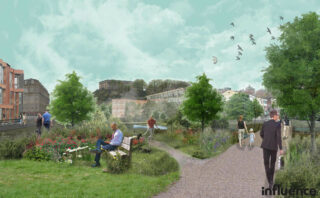5.1
5.1 Key trends
What would the regenerative city look like? We find evidence of structural changes unleashed in recent months that provide new opportunities for sustainable solutions, from sustainable and healthy buildings to electrified mobility of all shapes and sizes.
City halls are experimenting with many schemes with the goal of crafting neighbourhoods that work for communities rather than cars. This is essential to create equitable living environments. As it stands, disadvantaged communities (particularly as defined by race), lack access to many of the amenities of a sustainable city: they are less likely to have Zoom-able jobs, and their neighbourhoods have less green space but greater proximity to pollution.
- City halls are crafting neighbourhoods that work for communities rather than cars
- Sustainable and healthy buildings, electrified mobility and re-wilding will play key roles in the regenerative city
- As electric vehicles approach price parity, sales of internal combustion vehicles will be phased out by 2030
Tourist hotspots such as Venice saw stunning improvements in environmental quality, as tourists stayed away. Cities emptied out as offices closed and people left for the suburbs and rural areas.

New York City, March 2020. Image:Reuters/Carlo Allegri/Alamy

Venice. Image:DVrcan/Getty
Before the pandemic, urban populations were growing rapidly. But cities have emptied out in the pandemic. Will people return?
Baseline is average for same day of week, Jan 3rd to Feb 6th, 2020
Before the pandemic about 5% of American working hours were done at home. In April-May that rose to 60%. People living in urban areas have a new appreciation of open space.
Rents in city centres fell sharply, even as rents in rural and suburban areas have performed strongly. People are spending more time at home.
The early period in the pandemic saw big shifts in transport use. The changes are now less stark, but it is unclear if some changes will persist long term. The World Bank argues that COVID-19 has created new momentum for cycling and walking. The evidence from Britain shows that this is clearly true.
Higher historical PM2.5 exposures are positively associated with higher county-level COVID-19 mortality rates
Science, November 2020
Large-scale adoption of zero-emission vehicles could reduce deaths by many thousands a year, as well as making a critical contribution to climate goals.
Vehicle tailpipe emissions were linked to around 361,000 premature deaths from ambient PM2.5 and ozone worldwide in 2015.
International Council on Clean Transportation, 2019
5.2
5.2 Towards the regenerative city

A post-COVID-19 wildscape to replace a shopping mall in Nottingham, UK, as proposed by the Wildlife Trust. Image credit: influence
Paris Mayor Anne Hidalgo put the 15-minute city at the centre of her 2020 election campaign. In the past year, many cities have rolled out plans to make neighbourhoods more liveable and put people, rather than cars, at the centre.
Urban density makes walking a much easier choice for people. There is, however, wide variation in people’s access to amenities across different cities.
Residents of London, Paris, Madrid, Berlin and Milan were asked how far they had to travel to green space, a shop that sells groceries, a medical facility, a school, a restaurant or café, and a leisure centre or gym.
Over 2500km of new cycling routes and low traffic neighbourhood schemes have been announced in Europe since the pandemic began. 1500km of these have now been implemented.
Many of these schemes also incorporate rewilding (such as adding trees and plants and encouraging biodiversity) and have other objectives like enabling children to walk to school safely.
In some cities, areas where walking is easier have seen prices grow faster. However, the pandemic has closed the gap in recent months, as some people seek to relocate to more car-dependent suburban areas.
While residential energy use would rise, a reduction in transport would more than offset this. This IEA home-working scenario is based on just one day of working from home, which it finds would save around 24mtCO2 per year. Further savings could arise from a more comprehensive shift to home working, and via a reduction in long-distance travel for work. However, where people are using public transport to get to work, home-working actually leads to an increase in emissions.
Urban areas are typically much more environmentally efficient than suburban or rural ones. The higher a city’s density, the lower its emissions tend to be.
Buildings are responsible for over a third of global GHG emissions. New types of buildings, urban layouts and a faster pace of renovation all need to be leveraged to drive emissions down to net zero. “Embodied carbon“ – the CO2 emitted in producing materials – is a key issue. The importance of embodied carbon will rise over time as we decarbonise the energy we use in buildings.
The EU is accelerating the renovation of buildings, to achieve a wide range of social and environmental objectives: enhanced quality of life, fewer people in energy poverty, a reduction in greenhouse-gas emissions, improved material reuse and additional jobs.
Deep building renovation has big implications for solutions in the buildings space. Renovation rates need to increase by three times to align with net zero in the EU. In the UK, the deployment of heat pumps will need to ramp up more than ten times by 2030 to meet net-zero goals. Though daunting, this is well within what is technically possible.
The aim of the Renovation Wave is to at least double renovation rates from around 1% p.a. to 2% p.a. in the next 10 years and make sure renovations lead to higher energy and resource efficiency.
These improvements are being made for many different reasons — employee wellbeing, health, productivity and environmental concerns among them. Systems for environmental performance are the most advanced, but even these need to get much smarter.

Milan, Italy. An ecological house with garden on every terrace that turns the building into a vertical wood. Image: Pierluigi Palazzi / Alamy
While sustainability rating systems for buildings have been established for nearly 20 years, systems to specifically recognise healthy buildings are much more recent arrivals to the global scene.
McArthur, J. J., and Colin Powell. “Health and wellness in commercial buildings: Systematic review of sustainable building rating systems and alignment with contemporary research.“ Building and Environment 171 (2020): 106635.
Smart technology will play a key role in the sustainable buildings revolution, from the design of buildings and choice of materials, through to the operation of the building.
As well as integrating the whole building's value chain, technology can help to optimise the role of buildings in grid management, and integrate each building into the wider urban fabric.
If we are to truly ‘build back greener’, digital technology and decarbonisation will have to be placed at the centre of every construction phase, from inception to operation.
Schneider Electric
5.3
5.3 The race to electrified mobility reaches a tipping point
Over the past year, electric vehicles have hit the mainstream. There are now more than 7m electric vehicles on our roads and (as a chart further down shows) they can be plugged in at over 10m charging stations.
BEV = Battery Electric Vehicle.
Using a wider definition of EVs that includes Plug-in Hybrid Electric Vehicles (PHEVs), the total stock is now over 10 million
* Includes plug-in hybrid and fully electric models
In 2020 the world passed the milestone of 10m public charging stations.
Today an EV is roughly the same price as an ICE car. By the 2030s EVs will be significantly cheaper, largely due to falling battery costs.
Although small in scale, the number of electrical aviation developments has been growing fast.
Sweden and France are banning short-haul airplane flights where trains are available. This could help create a niche for electric planes.